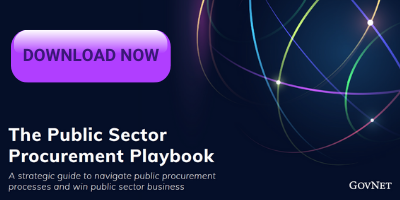Inside Secrets to Winning Public Sector Contracts
What is the public sector bidding process? How do organisations win public sector contracts? What are the best practices for public sector contract bidding? These questions might have flashed up in your mind before - or you may be familiar with the process but would like to delve deeper for more nuanced answers or insights on something you might not have seen before.
 In this article, we’ll explore the answers to all these questions and provide you with the inside secrets to winning public sector contracts.
In this article, we’ll explore the answers to all these questions and provide you with the inside secrets to winning public sector contracts.
Public Sector Contracts: An Overview
When a public sector organisation needs products or services, they publish a contract (a tender notice or document). This kicks off the procurement process, which also includes stages such as submitting tender responses, supplier evaluation and delivery. This contract is then bid for by private companies. Tenders are published on Contract Finders (for contracts over £10,000) and Find a Tender (for contracts over £118,000).
In short, the procurement process follows this structure:
- A public sector organisation needs a certain product or service.
- They publish a tender notice in the OJEU.
- Private companies find the tender notice within online web portals which show active tenders.
- Tender responses are given by those companies and received by the issuing organisation.
- The responses are evaluated by determining the suitability of the bidding party concerning predetermined evaluation criteria.
- All potential suppliers are notified and given feedback on their submissions.
- The successful bidder is issued with an Invitation to Tender (ITT).
- A standstill period is observed - between the notification of a successful bid has been given and the final contract is signed. Other bidders can also challenge the decision.
- The contract is formally signed and delivery can begin.
So where are these opportunities found?
Finding Opportunities First
Every single public sector organisation is required by law to publish their contract notices to ensure competition and transparency. You can find contracts in the following sources:
Official Databases
There are several official tender databases, such as TED (Tenders Electronic Daily) or via the GOV.UK Contracts Finder. TED publishes tenders which are above the Official Journal of the European Union (OJEU) threshold.
In contrast, GOV.UK’s Contract Finder lets you search for contracts worth over £10,000. For high-value tenders, you can use the Find a Tender service. These tenders are usually above £118,000.
Tender Alert Services
Services like these let set up personalised feeds related to the type of tenders you’re interested in. You can receive automatic email notifications when new tender opportunities are published. These are helpful tools for teams that would rather spend time on other important tasks rather than trawling through tender lists.
Procurement Portals
Similar to tender alert services, private companies run these portals. However, what you pay in subscription fees is worth the well-researched high-value contract notices.
National Portals
Each country within the UK has its own national tender portal. England’s is the aforementioned Contract Finder. You can find other countries at:
- Scotland: Public Contracts Scotland
- Northern Ireland: eTendersNI
- Wales: Sell2Wales
Procurement Frameworks
A procurement framework, which is also known as a Framework Agreement, is an arrangement where buyers set the terms far in advance. This could be four years before a contract is actually needed to be supplied. Buyers will select suppliers and set terms and prices in this time period.
Being awarded a spot on procurement frameworks is a sign of a significant reputation within an industry.
Examples of procurement frameworks are:
- Crown Commercial Service: Sponsored by the Cabinet office, the CCS brings together policy, advice and direct buying for both finding contracts and suppliers.
- YPO: The YPO is a publicly-owned central purchasing body. Suppliers can register through the YPO to be considered for public contracts.
- ESPO: Similar to YPO, ESPO also helps public sector organisations with their purchases. Suppliers can also register as an ESPO member to be considered for contracts.
A complete tender process is required from suppliers in order for them to gain a place on a framework.
Secrets to Success
There’s no limit to the number of ‘inside secrets’ you can find. Some of them are universal; others aren’t. What truly matters is adapting your bid to the specific tender and context your bidding on and into. However, here are a few secrets that’ll guarantee you a better chance of success.
Develop Relationships With Your Targets
First of all, identify the organisation most likely to purchase your goods and services. Then do your research and answer these questions:
- What is their typical spend?
- Do they have spending patterns?
- Who are their current suppliers?
- What does each supplier offer them and for how much?
If you can, actually meet the key persons within the organisation. This can be a little difficult, but it’s worth the effort. Networking opportunities can stand you in good stead, implicitly showing your value as a potential supplier. Industry-relevant events, such as conferences, are the best place to try and do this.
But remember, don’t be pushy and always act with perseverance.
Perfect Your Tender Responses
Suppliers need to pay close attention to the criteria stipulated in the tenders - failure to do so could result in failure to secure the contract.
Essentially, there are three forms of tender procedure for contracts above what is known as the EU Threshold:
- Open: Anyone can request tender documents and submit a bid. This format isn't usually used if the contract issuer is expecting a large number of responses.
- Negotiated: A single-stage tender carried out between the issuer and one supplier.
- Competitive Dialogue: Potential suppliers can submit initial solutions after success in the selection stage.
Take these differences into consideration when creating your response. You'll also have to fully show you can meet the contract’s financial requirements, have the technical ability and expertise to satisfy the need for goods or services and have the actual capacity to get it all across the line.
If you can't accurately portray all of this in your tender response, then you won’t be asked to submit a formal bid. For more information on how to write an effective tender response, read our blog here.
How to Bid
So what are the steps you need to take when bidding for public sector contracts?
Write Your Bid
This will include your proposal evidence, covering areas such as statistics or performance, testimonials and case studies - plus a multitude of other information.
A bid - or tender response - needs to satisfy a number of criteria. While these change with each contract, there are a number of set things that will always be present:
- Achieving value for money
- Simple and effective delivery strategy
- Contextual considerations
- Sequential evaluation of price and quality
- An evaluation of proposed social value
- The need for innovation
Buyers are looking that you can accurately and effectively provide for their needs in the most economically advantageous way. The bid needs to reflect that.
You can find all the things to include on the GOV.UK article. Similarly, you can also use the ‘Bid Evaluation Guidance Note’. While aimed at public sector buyers and how they should evaluate bids, private companies can flip this advice and use it to guide themselves on what buyer’s criteria will be.
Check Your Bid
The key things to look out for are failing to answer the questions fully and failing to address the specific requirements. Missing out information is a simple mistake to make, but could result in a lost opportunity.
Proofreading is also a key thing to remember. This should always be done by more than one person and should look for factual errors alongside grammatical ones. Also, if there’s a stipulation on word count, always keep to it.
Bidding
The bidding procedure will then take one of the three forms that we spoke about previously. The tender document will supply you with the information on which payment model type will be utilised, of which there several methods, such as a fixed price, a service fee or staged payments.
The bid is then evaluated through several ‘gates’, which are:
- Administrative compliance.
- Economic and financial standing.
- Technical and price evaluation.
Your bid will be ‘scored’ based on these evaluations. If you’ve satisfied all the requirements and have created a good quality tender response, you’ll have a good chance of finally winning the public sector contract you’ve bid on.
The Public Procurement Playbook
Want to learn more about the public sector procurement process and win more public sector business? Download the Public Procurement Playbook.
Topics Covered Include:
- Public Procurement Trends & Stats
- How to Target and Find Contracts
- Improving Sales Potential & Outreach Tips
- Tips for Winning Contracts
- Managing the Bid Process
- Links to Other Useful Resources



